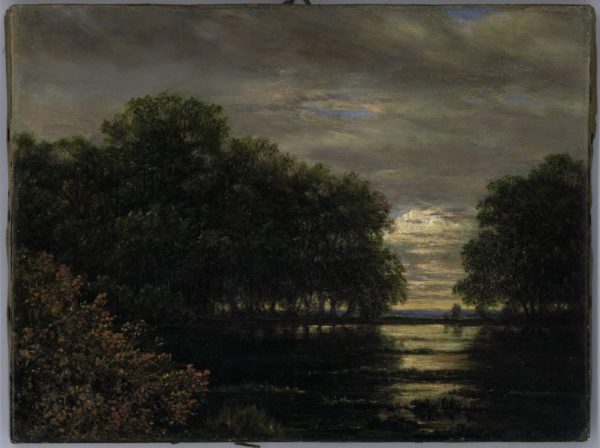Flood in the Rosental Valley, Leipzig, c. 1835-1840
Oil on canvas, H. 0.21 m; W. 0.28 m
Ink inscription on the stretcher: (…) Von Professor C.G. Carus / gemalt / Rietschel / (…)
Provenance: Ernst Friedrich Rietschel (1804-1861), Dresden
Private collection
Elisabeth Bülck, C. G. Carus, sein Leben und sein Werk im Verhältnis zu C. D. Friedrich und dessen Schülern betrachtet, unpublished Phd theses, Greifswald, 1943.
Marianne Prause, Carl Gustav Carus. Leben und Werk, Berlin, 1968, p. 143, no. 261.
This work is closely related to Carus’s River Landscape in the Rosental, near Leipzig (Kunsthalle Hamburg), which Prause dates 1838-1840 in her catalogue raisonné (no. 260). While recording and illustrating the present work as catalogue no. 261, Prause does not date it, nor indicate whether it served as a study for the larger landscape, which seems likely, or was developed from the larger work at a later date. The relatively loose brushwork and interest in effects of colour are consistent with small oil studies and paintings that Prause dates in the mid-1830s and after.
A highly successful physician by profession, Carus is known to us principally for his landscape paintings and writings on psychological and aesthetic topics, including his Neun Briefe über Landschaftsmalerei (Nine Letters on Landscape Painting, completed in 1824, published in 1831). In both the breadth and content of his far-ranging projects, ranging from studies of animal anatomy, plant morphology and geology, to prescient musings on the human unconscious, he emerges as a great representative of the age of Goethe. As is evident in the Briefe in particular, it was Carus’s overarching ambition to unite the symbolic aspirations of German Romanticism with the empirical commitments and methods of science. Carus invented the term ‘Erdlebenbild’ (‘earth-life painting’) in the Briefe to describe a landscape practice based on scientific knowledge of the underlying structures of natural formations, such as mountains, and the observation of changing phenomena, such as light.
The present work represents one of Carus’s favorite subjects, a tranquil landscape bathed in moonlight. Moonlight themes were first developed to great effect in the Romantic era by Carus’s friend (since around 1816) and earliest mentor, Caspar David Friedrich (1774-1840). But Friedrich’s influence on Carus waned from around the mid-1820s, as Carus became increasingly interested in naturalist aesthetics, party guided by the examples of Johann Wolfgang von Goethe (1749-1832), with whom he frequently corresponded; Alexander von Humboldt (1769 -1859); and the oil sketches of the Norwegian landscape painter, Johan Christian Dahl (1788-1857). Interestingly, the Rosental park near Leipzig, the subject of the present work, was also the subject of Carus’s earliest recorded painting, Frühlingslandschaft im Rosental of 1814 (Dresden, Staatliche Kunstsammlung, Prause no. 259), whose severe style of execution and rather dramatic composition are in keeping with Carus’s early work. By contrast, paintings like the present work aim to invoke a powerful sense of mood with their closer viewpoint and focus on light and colour effects.
Ernst Friedrich Rietschel (1804-1861) was an immensely successful sculptor who specialized in monuments of distinguished German historical figures and contemporaries. He also owned many other paintings by Carus.

